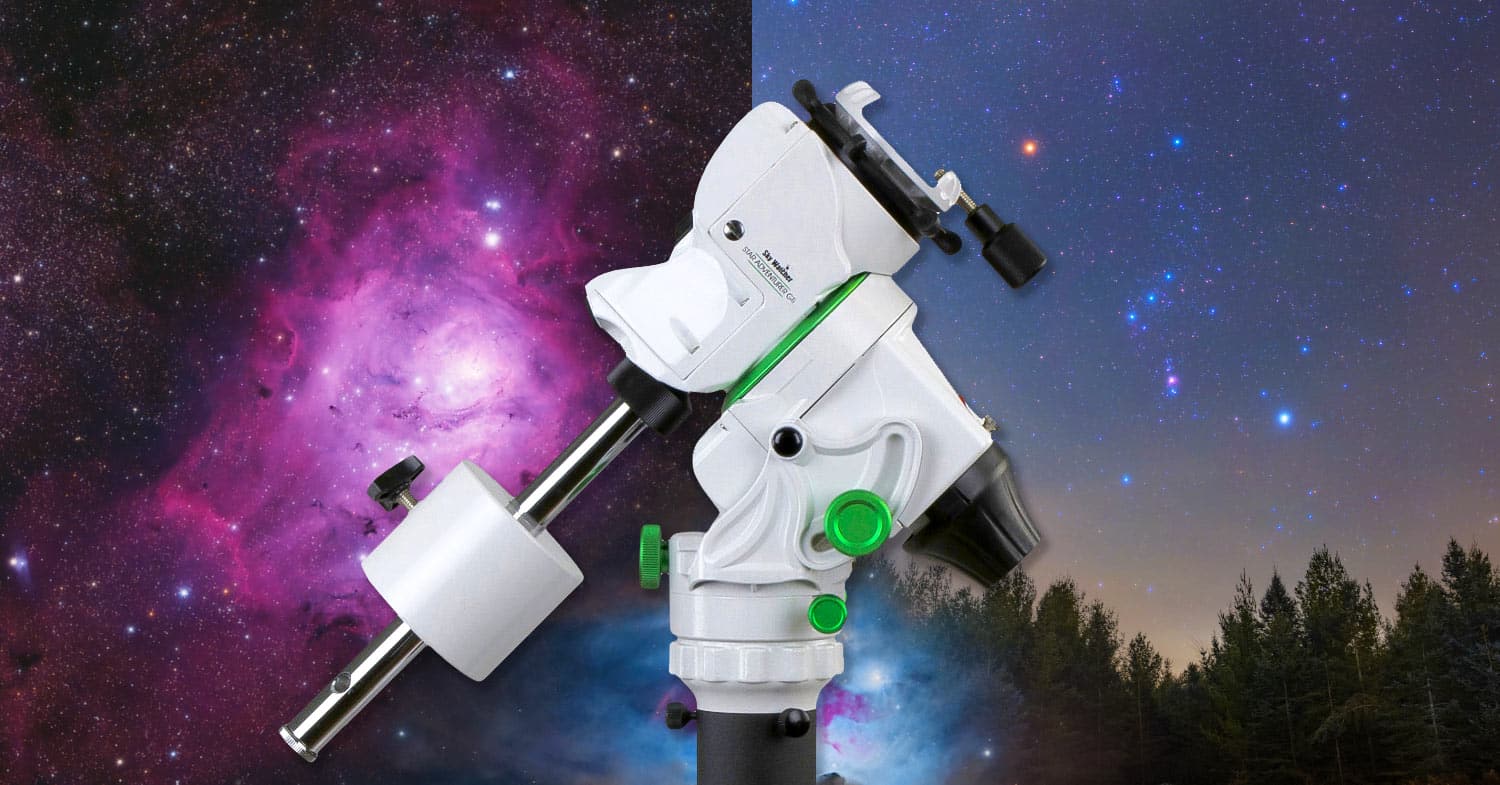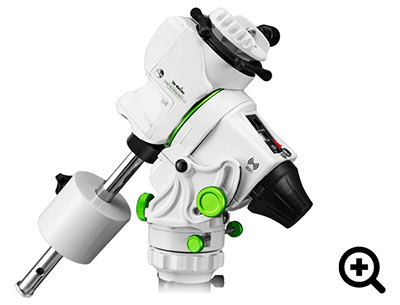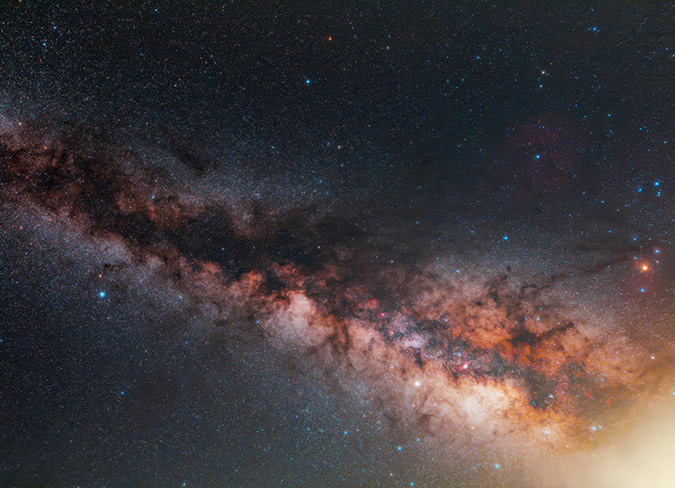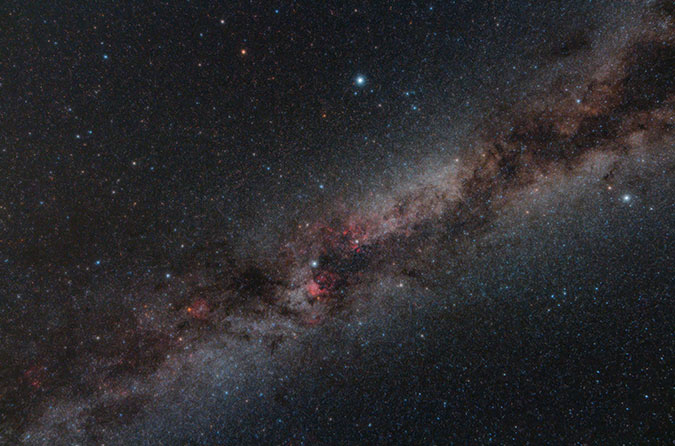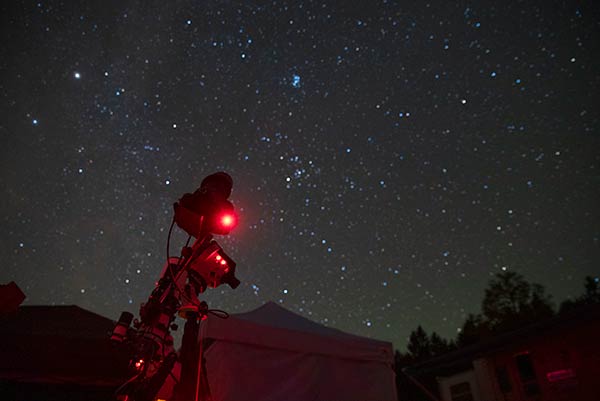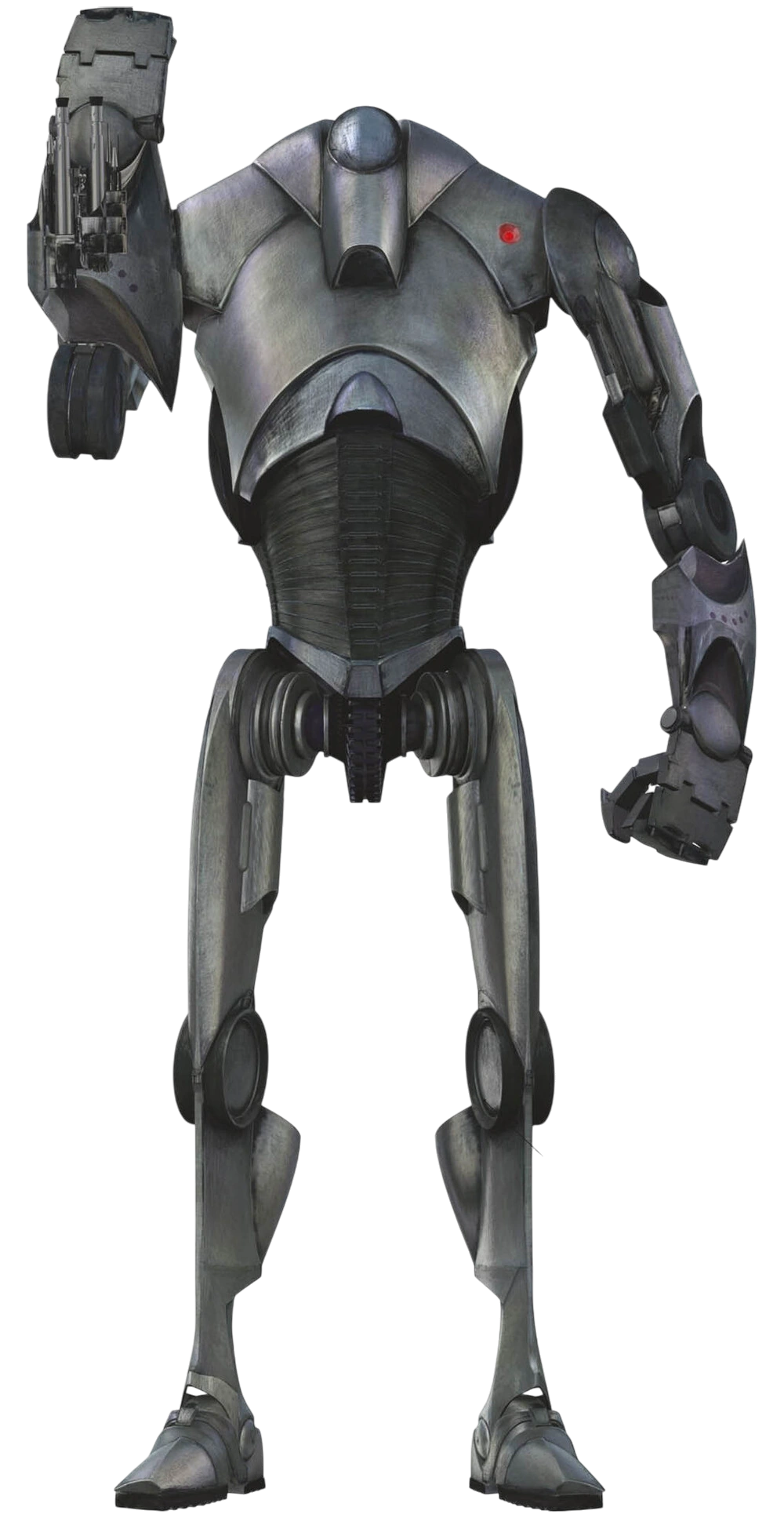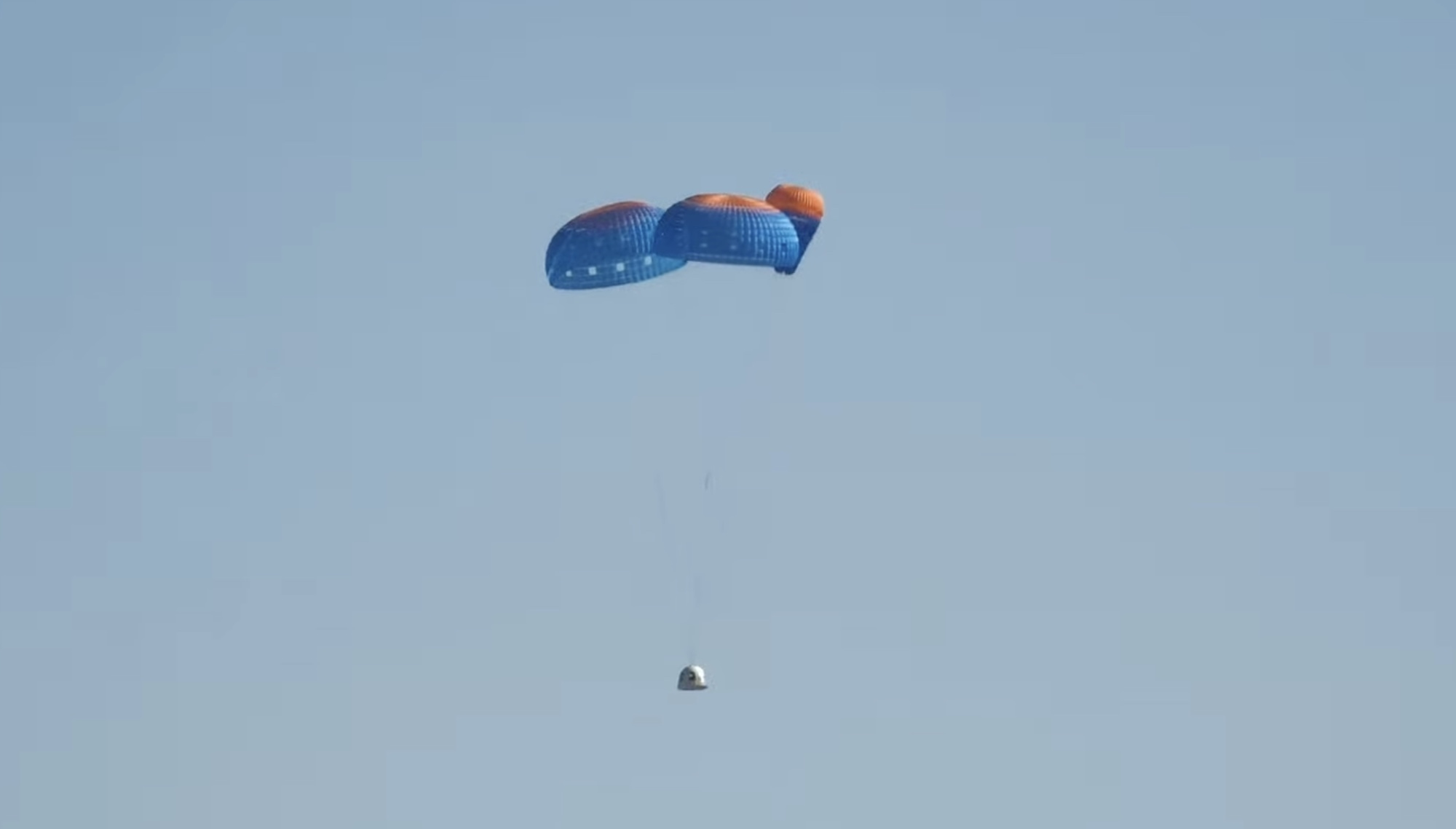Updated April 22, 2024
A star tracker is a portable tracking camera mount designed for astrophotography. The device ‘tracks’ the motion of the stars to allow you to take long exposure images of space without star-trailing.
These devices are commonly used with a DSLR/Mirrorless camera and lens, or even a small astronomical telescope. Recent models now include dedicated smartphone apps to manage your imaging session and even point to deep-sky objects in the night sky.
Star trackers are now more accessible to amateur photographers than ever, with many options to choose from. Deciding which one to spend your hard-earned money on can be daunting.
A star tracker is an important piece of equipment for those who travel for astrophotography.
Quick List
Unlike websites that tell you what to buy without showing any actual photos taken using the equipment, I have used each one of the star trackers mentioned above extensively.
I am a full-time astrophotographer who has used many different star trackers from several brands for many years. I have created this resource for those looking to finally dive into astrophotography the right way, with a star tracker.
If you’re looking for a reliable star tracker that is portable, can handle a small telescope, and includes GoTo functionality (that points to objects for you), I highly recommend the Sky-Watcher Star Adventurer GTi.
This model can handle a small refractor telescope such as the William Optics RedCat 61 (shown below) or similar. It’s a great starter mount for astrophotography that includes advanced features like GoTo, autoguiding, and can even plate-solve using a device like the ZWO ASIAIR Plus.
At the cost of about $800 USD (at the time of writing), this star tracker is by no means ‘cheap.’ However, compared to the average equatorial tracking mount for astrophotography, this is at the very bottom end. For even more affordable models lacking advanced features, the GTi has, read on.
While many first-time astrophotographers prefer to purchase a star tracker that can handle a small telescope when they’re ready, there are many options available for smaller setups like a DSLR camera and lens. For example, one of my favorite star tracker configurations includes my Canon EOS Ra camera, a Sigma 24mm F/1.4 lens, and a simple intervalometer to automate the exposures.
The Sky-Watcher Star Adventurer GTi with a small telescope and mirrorless camera attached.
The Best Star Trackers for Astrophotography
When it comes to astrophotography, a star tracker allows you to take better images. Your exposure lengths are no longer limited to 30 seconds or less due to a moving sky, and you can dial back camera settings like ISO and F-stop.
Equatorial camera mounts are designed to align with the polar axis of the night sky so you can take long-exposure images that are free of star trailing. Astrophotography demands long-exposure tracked images to collect as much signal (light) as possible, and that is exactly what a star tracker allows you to do.
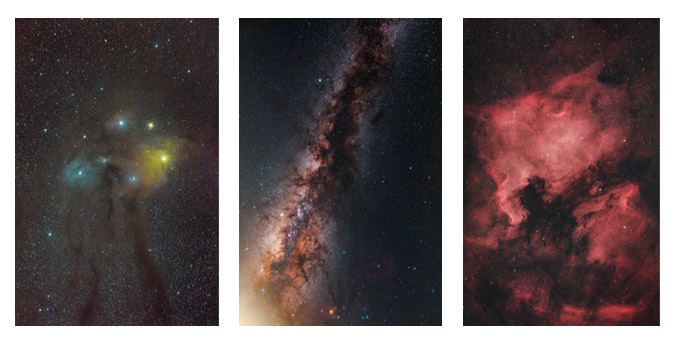

All of these photos were captured using a portable star tracker mount.
Over the years, I have had many opportunities to review star trackers for astrophotography. I have learned that portable tracking camera mounts can vary depending on the brand you choose, from the mechanical design to the polar alignment procedure.
In this post, I’ll discuss the topic of using a star tracker for astrophotography, and compare some of the best choices available in 2024. If you are interested in capturing Nightscapes or Milky Way Photography, a star tracker is arguably the most important investment you’ll make in equipment.
To be effective, a star tracker needs to be capable of accurately tracking the night sky for long-exposure night sky photography. Each model available has its strengths and weaknesses, from the portability factor to maximum payload capacity.
I’ll do my best to explain why the overall user experience is the number one factor to consider when choosing a portable tracking camera mount. Here is a list of my top choices to consider:
The Types of Images You Can Take
Before I go any further, I want to remind you of the kinds of images possible on a star tracker. There are plenty of night sky photographs shared on Instagram and other social media platforms from adventurous locations, and some of them are downright phenomenal.
However, many of them are ultra-wide field shots of the sky, lacking the reach needed to reveal wonderous deep-sky objects such as nebulae and galaxies. Being a deep-sky astrophotographer means that I aim to expose the incredible objects seemingly hidden in our night sky, and a star tracker helps me accomplish this.
Make no mistake, a star tracker gives you the ability to dive into the deep sky. The photo below showcases many incredible deep-sky objects from the California Nebula to the Pleiades.
![]()
![]()
Deep-Sky Astrophotography using a Star Tracker. Canon EOS Ra, Canon RF 15-35mm F/2.8 on a Sky-Watcher Star Adventurer.
How to Use a Star Tracker
A star tracker matches the rotation of the Earth so that you can take long-exposure images (at nearly any focal length) of the night sky. To properly track the stars that appear to move across the night sky each night, a star tracker must be polar-aligned and balanced.
To polar align an equatorial mount for astrophotography (including a small camera tracker), you need to adjust the base’s altitude and azimuth so that the mount’s polar axis is aligned with the celestial pole. In the northern hemisphere, we can use the north star, Polaris, to aid in this process.
A portable star tracker with a ball head and DSLR camera attached.
Without using a star tracker, the stars in the night sky will begin to trail after about 15-30 seconds, depending on the focal length of the lens used. This is because the Earth is spinning on its axis while the night sky is fixed. Amateur photographers using a stationary tripod can use the 500 rule as a guide for choosing the ideal shutter speed, but a star tracker removes this limitation altogether.
When a tracking camera mount is used, a small motor slowly rotates your camera in the right ascension, effectively matching the apparent movement of the night sky and freezing it in its tracks. The image below shows you what a 3-minute exposure using a 400mm lens would be like without using a star tracker. ![]()
![]()
Long exposure images (180 seconds) shot at 400mm with and without tracking.
The Portability Factor
Luckily for amateur astrophotographers and photographers, there are many great star tracker options to choose from these days. Unlike a heavy equatorial telescope mount, a star tracker is portable, small, and lightweight. Because of its small size and compact profile, it’s usually a lot more affordable, too.
The star tracker category includes small EQ mounts that can carry a camera and lens combo, whether it’s for wide-angle Milky Way photography or deep sky imaging with a telephoto lens. Wide-angle nightscapes and Milky Way panoramas are the star trackers’ strong points. These types of projects usually involve traveling to a remote location, where packing light is necessary.
If you’ve ever seen a detailed photo of the Milky Way like the one below, chances are the photographer used a star tracker to collect sharp, long exposure images with their camera and lens.
The Milky Way from a dark sky location. Stack of 60 x 2-minute exposures at ISO 1600.
A star tracker usually includes a polar scope, which helps find the north celestial pole and adjust the mount accordingly. A star tracker that has been properly polar aligned matches the exact apparent rotation of the night sky to freeze deep-sky objects in place.
Many of the star trackers available online today come in potentially confusing packages and bundles. My advice is that you invest in a system that can handle your intended payload (and then some) and provide you with features that make imaging in the field easier and more enjoyable.
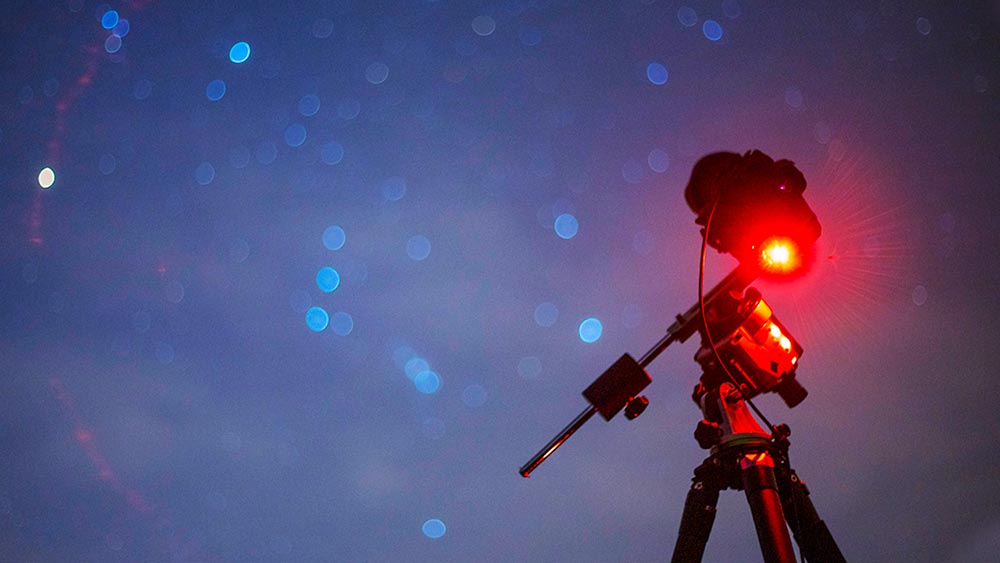

A camera mount with motorized equatorial tracking capabilities is useful for photographing wide swaths of stars in the night sky and the solar system. Compensating for the rotation of the Earth can also make moon photography easier.
You can also photograph planets at short focal lengths on a star tracker, as seen in the image of the planet Venus and the moon below. As long as the mount has been polar aligned and balanced, longer focal lengths (up to about 500mm are practical)
The portable, free-spirited nature of a device like this allows for quick setup at a moment’s notice. This means that you can promptly get your camera oriented and start capturing the moon or planets when a significant event, such as a lunar eclipse or grouping, is taking place.
The planet Venus and the crescent moon. Canon EOS R6, Canon EF 400mm F/5.6, Sky-Watcher Star Adventurer.
A star tracker is also a popular option for those traveling to a total solar eclipse. It is the perfect mount for your camera and lens, with a certified solar filter in front, of course.
In fact, I used the Sky-Watcher Star Adventurer GTi to photograph the Total Solar Eclipse in 2024. The tracker allowed my telescope to stay centered on the Sun to capture each stage of the event.
Popular Models in the “Star Tracker” Category
If you are a beginner in the world of astrophotography (see my beginner’s guide), investing in a tracking camera mount is the single biggest advancement you can make in terms of gear. You can now let the exposure time do the heavy lifting without relying on fast optics and high ISO settings to collect a decent amount of signal.
The following tracking camera mounts share many similarities, including the ability to track the night sky at different speeds. Before investing in a dedicated star tracker for landscape or deep-sky astrophotography, make sure the bundle you order includes everything you need to mount your camera and lens.
Which one should you invest your hard-earned money in for astrophotography? That will depend on the type of user experience you are looking for, and my goal for this article is to highlight the key differences in the user experience for each mount.
If you’re just looking to shoot wide-angle astrophotography using a camera lens, I have good news. All of the star trackers mentioned above can accurately track the night sky for incredible long-exposure images like the one below.
Canon T3i and Rokinon 14mm F/2.8 lens on the iOptron SkyTracker Pro.
What Star Trackers Do Best
These mounts are primarily designed for wide-angle astrophotography, meaning projects like Milky Way panoramas or mid-range focal length compositions using a 100-200mm telephoto lens. That’s not to say that you can’t use a star tracker for high-magnification deep-sky imaging, but that will demand the most of your tracker and require a diligent setup routine.
The portable nature of a star tracker often leads to some of the most memorable deep sky astrophotography sessions in the field, as they offer you the freedom to travel to a dark sky location without a trunk full of gear. One of my most incredible astrophotography adventures was setting up an iOptron SkyGuider Pro and William Optics RedCat 51 telescope to capture the Carina Nebula from Costa Rica.
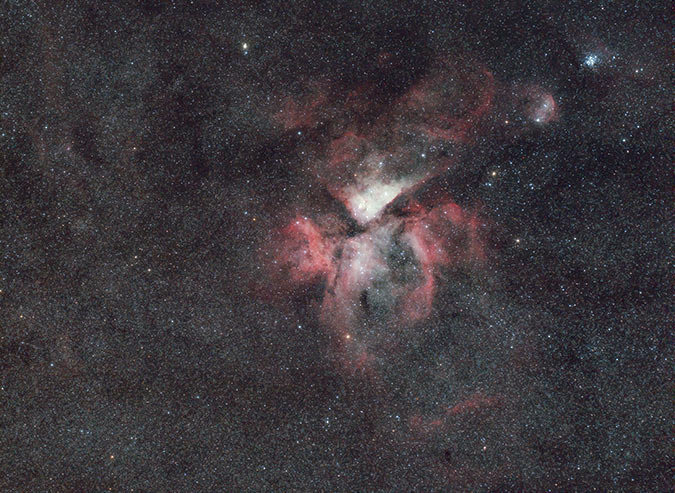

The Carina Nebula from Costa Rica (9-minute exposure using a star tracker and small telescope).
It simply wasn’t possible to bring my computerized telescope mount to this location (on a plane), yet a star tracker fit in my carry-on bag and allowed me to collect tracked images of the night sky from the middle of the resort. These are the kinds of adventures you can expect when you invest in a portable star tracker for astrophotography.
Key Benefits of a Star Tracker
- Quick Setup and Alignment
- Lightweight and Portable
- Great for Travel
- Built-in Battery Power*
- Great for Camera Lens Astrophotography
* The Fornax Mounts LighTrack II requires an external 12V power source.
From my experience using star trackers for astrophotography from the backyard and beyond, I believe the most important aspect to consider is the user experience. If the star tracker is not easy to use in the field, or the process of setting up takes too long, you won’t use it as much. That’s all there is to it.
As any experienced amateur astrophotographer will tell you, your motivation to stay up all night and image will vary. Any additional friction between you and a successful image affects your decision to step outside on a less-than-perfect night.
Don’t forget about the tear-down process, either. If the clouds roll in and it looks like rain is coming, a lengthy teardown routine can become stressful. Star trackers can usually be carried inside the house with all elements attached at a moment’s notice. The same can not be said for a full-blown deep-sky astrophotography kit.
A star tracker should allow you to quickly get up and running under a clear night sky. It should be a pain-free experience that provides the freedom and flexibility to take amazing astrophotography images wherever and whenever you want.
Which Star Tracker is Right For You?
I am hesitant to state which star tracker is “best”, as I have found them all to have their strengths and weaknesses in terms of user experience in the field. For most people, the Sky-Watcher Star Adventurer GTi is the ultimate solution (because of its GoTo functionality), but others may not need this feature and prefer something a little more compact.
I often see comments from beginners about being limited to a maximum exposure time using a particular mount before the stars begin to trail. I honestly believe these situations are almost always due to user error in the polar alignment and balancing procedure.


Every star tracker I have ever used for astrophotography was capable of sharp, 3-minute exposures using a focal length of up to 200mm. A portable star tracker must be accurately polar aligned and balanced to work properly. This may seem obvious to most people, but time and time again I see poor results being blamed on the hardware itself.
My portable star tracking mounts have traveled with me to some amazing places and captured some of my favorite astrophotos. Both of the iOptron star trackers I am about to cover are extremely popular in the amateur astrophotography and nightscape photography community and for good reason.
Sky-Watcher Star Adventurer GTi
Best Suited For: Wide-field deep-sky Astrophotography with a Telephoto Lens or Small Telescope
Although this star tracker is the heaviest model on this list, the Sky-Watcher Star Adventurer GTi is still highly portable and a fantastic choice for astrophotography. Unlike the original Star Adventurer (and 2i model), the GTi model can also find deep-sky objects in the night sky using the SynScan GoTo system.
This is extremely useful for beginner astrophotographers who don’t know where to find deep-sky objects in the night sky. Using the dedicated SynScan Pro mobile app, users can select from a large database of targets (Messier, NGC, IC catalogs), and the mount will automatically point to the target for you.
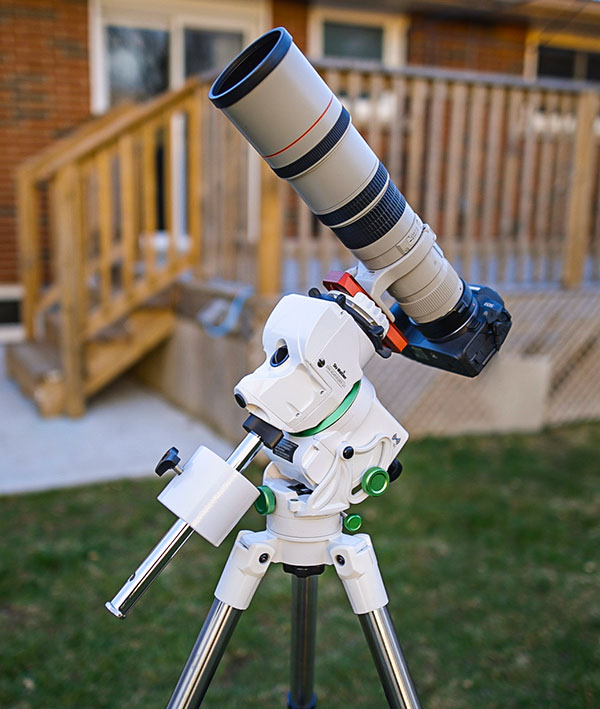

The Sky-Watcher Star Adventurer GTi.
For the pointing accuracy to be correct, you must make sure that your location is set and that the mount is polar aligned and balanced. The Star Adventurer GTi has a robust wedge base suitable for mounting cameras with long telephoto lenses and compact telescopes.
This mount has a built-in autoguiding port (ST-4) and a USB Type B port to connect your computer to the mount for direct control (ASCOM/EQMOD). My favorite feature of the Star Adventurer GTi is the adjustable illuminated reticle, which helps you in the polar alignment process while in the field.
- Weight: 5.7 lbs.
- Max Payload: 11 lbs
- Max Useful Focal Length: 500mm
- Built-In Battery: Yes (8 x AA batteries)
- Built-In Polarscope: Yes
- Autoguider Input: Yes
iOptron SkyTracker Pro
Best Suited For: Nightscape and Milky Way Photography with a Camera Lens
If you’ve watched any of my previous videos, you’ve probably seen the iOptron SkyTracker Pro in action. This ultra-lightweight star tracker is iOptron’s latest variation of their incredibly popular and affordable wide-angle astrophotography mount.
The SkyTracker Pro (not to be confused with the SkyGuider Pro) weighs just 2.6 pounds and houses everything you need for long-exposure nightscapes in a little red (or black) box. A plastic box that is, with adorably simple controls to accelerate the RA axis to your intended target.
![]()
![]()
The iOptron SkyTracker Pro with a DSLR camera and a wide-angle lens attached.
- Weight: 1.5 lbs.
- Max Payload: 6.6 lbs
- Max Useful Focal Length: 200mm
- Built-In Battery: Yes (Li-Poly 3.7V)
- Built-In Polarscope: Yes
- Autoguider Input: No
This camera mount was designed for wide-field nightscape images using a DSLR camera and lens. Many people have had great success using the SkyTracker with an ultra-wide-angle lens like the Rokinon 14mm F/2.8, all the way up to some heavier glass such as the Rokinon 135mm F/2.
It’s the most affordable star tracker I’ve used, and it has delivered exceptional results using several different camera lenses. One such instance was the time I used the SkyTracker Pro with my Canon EF 24-105mm F/4L Lens to shoot Mars and the Pleiades star cluster in the same frame.
The Planet Mars alongside the Pleiades Star Cluster. iOptron SkyTracker Pro and 24-105mm lens @ 105mm.
iOptron SkyGuider Pro
Best Suited For: Nightscapes, Milky Way Photography, and Wide-Field Deep-Sky Imaging
The iOptron SkyGuider Pro is a big step up from the Tracker, offering a heavier payload capacity, a more robust design, and the ability to autoguide your images. The iOptron SkyGuider Pro is a top contender in the category of star trackers with stellar reviews from experienced nightscape photographers.
This portable EQ mount fits in the palm of your hand, yet can handle up to 11 lbs of imaging gear. With the counterweight kit attached, the SkyGuider has no trouble with larger telephoto lenses and even small refractor telescopes such as the William Optics RedCat 51.
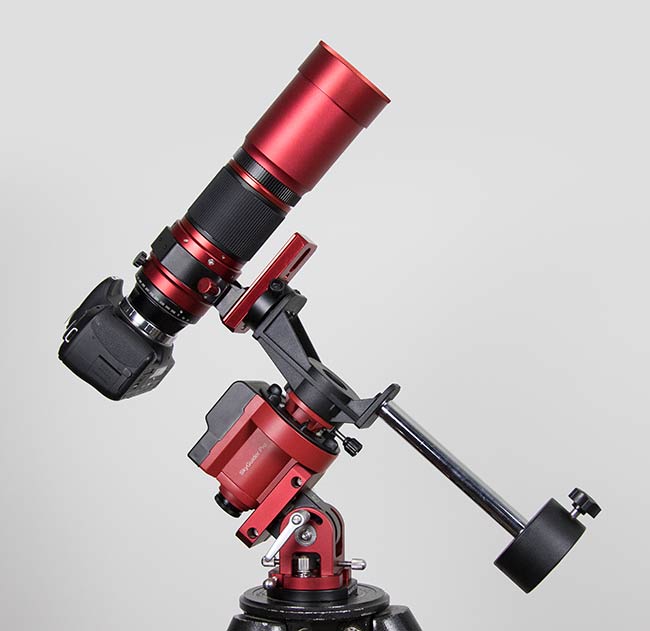

The William Optics RedCat 51 is a great match for the SkyGuider Pro.
- Weight: 2.2 lbs.
- Max Payload: 11 lbs
- Max Useful Focal Length: 400mm
- Built-In Battery: Yes (Li-Poly 3.7V)
- Built-In Polarscope: Yes (Illuminated)
- Autoguider Input: Yes
Beginners often mix tracking and guiding or assume they both mean the same thing. Tracking is the act of matching the rotation of the Earth using an RA (right ascension) motor, with the axis of the mount aligned with the celestial pole. Guiding is a specialized astrophotography technique that uses a secondary camera to lock on to a guide star and sends small commands to the mount to improve tracking accuracy.
The iOptron SkyGuider Pro includes an ST-4 autoguide port that allows you to autoguide using the appropriate cabling and software on your computer. Although autoguiding is a powerful feature that allows for even longer exposures (and the benefits of dithering), it requires additional hardware to run.
The North America Nebula in Cygnus. iOptron SkyGuider Pro with William Optics RedCat 51 attached.
For smaller loads, such as a DSLR camera and 50mm lens, you can simply attach a ball head to the 1/4″ threaded socket on the mount. Heavier camera lenses or small telescopes will need to be mounted to the declination plate and utilize the counterweight system (shown above.)
For those who prefer to polar align their SkyGuider Pro electronically, the iOptron iPolar device was designed to fit neatly inside this camera tracker. Be advised, that once you make this modification to the mount (or order a version with the iPolar included), you lose an element of portability with the need for dedicated software control.
Sky-Watcher Star Adventurer
Best Suited For: Nightscapes, Milky Way Photography, and Wide-Field Deep-Sky Imaging
The Sky-Watcher Star Adventurer Pro is responsible for one of my favorite images I have ever taken of the Andromeda Galaxy (shown below). This portable star tracker is easy to polar align, and the pro pack comes with everything you need to mount your DSLR camera, lenses, and even a small telescope.
The following image was captured using a Canon 60Da and a William Optics RedCat 51, mounted to the Sky-Watcher Star Adventurer Pro. I stacked 100 x 2-minute exposures at ISO 1600 for an unforgettable shot of M31.
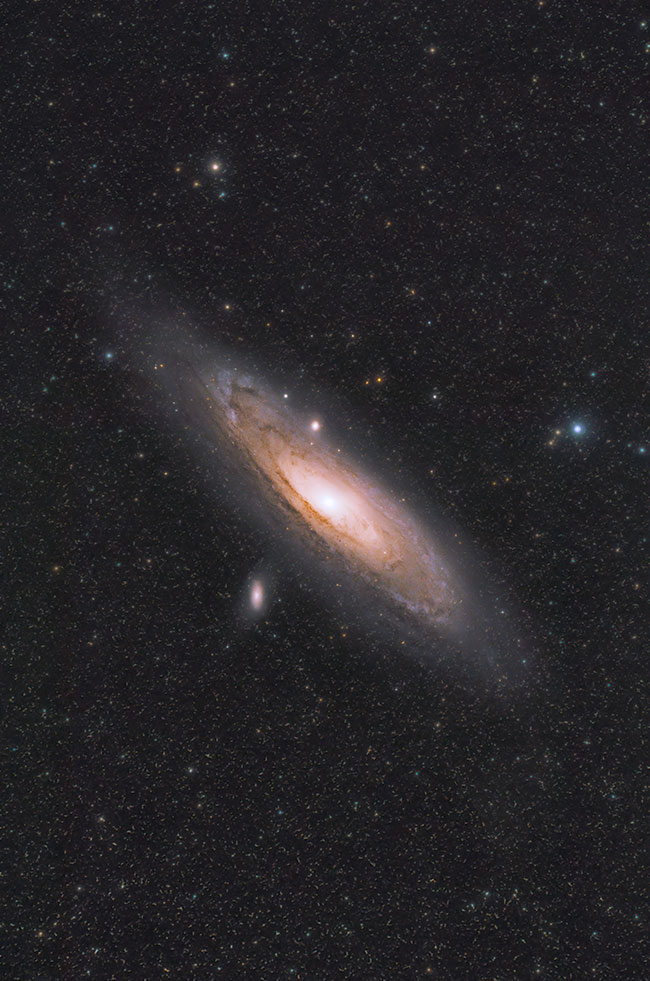

The Andromeda Galaxy captured using the Sky-Watcher Star Adventurer Pro.
When comparing the specs between the iOptron SkyGuider Pro, and the Sky-Watcher Star Adventurer Pro, you’ll notice several similarities. For example, the “Pro Pack” includes a counterweight kit, wedge base, and a built-in illuminated polar scope.
- Weight: 2.2 lbs.
- Max Payload: 11 lbs
- Max Useful Focal Length: 400mm
- Built-In Battery: Yes (4 x AA)
- Built-In Polarscope: Yes
- Autoguider Input: Yes
The Star Adventurer includes a built-in WiFi, Android/iOS App control for those looking to control projects such as time lapses with your DSLR. Like the iOptron models I mentioned above, the Star Adventurer includes modes for solar, lunar, sidereal, and half-sidereal tracking rates.
I like that the Star Adventurer can run on 4 AA Batteries. Although it may seem like a step backward from a rechargeable li-poly battery, this feature may come in handy when you are taking pictures nowhere near a source of power. Sky-Watcher reports that these batteries can power the mount for up to 72 hours, more than enough time for a night or imaging or two.
I found the Sky-Watcher Star Adventurer Pro to deliver an exceptional user experience right out of the box. This portable star tracker’s hardware and premium finishes really stood out to me, and I love the mounting bar and counterweight kit.
Using the Sky-Watcher Star Adventurer at the Black Forest Star Party in September 2019.
Star Tracker Comparison Chart
Here are the bare-bones specs of the star trackers mentioned in this post. The listed “longest useful focal length” is merely a point of reference. In reality, I believe all of these trackers could handle a 2-minute exposure using an even longer lens.
| Brand | Mount | Weight | Maximum Payload | Max. Useful Focal Length | Built-in Battery | Autoguide Port |
|---|---|---|---|---|---|---|
| iOptron | SkyTracker Pro | 1.5 lbs. | 6.6 lbs. | 200mm | Yes | No |
| Sky-Watcher | Star Adventurer GTi | 5.7 lbs. | 11 lbs. | 500mm | Yes | Yes |
| Sky-Watcher | Star Adventurer | 2.2 lbs. | 10 lbs. | 300mm | Yes | Yes |
| iOptron | SkyGuider Pro | 2.2 lbs. | 11 lbs. | 400mm | Yes | Yes |
| Fornax Mounts | LighTrack II | 2.8 lbs. | 13.2 lbs. | 500mm | No | Yes |
What’s The Next Step Up?
A star tracker is perfect for photographers who want the ultimate level of portability and simplicity for their astrophotographer projects. However, the star tracker category of camera mounts caps out at about 11 pounds worth of gear.
If you are looking to get into deep-sky astrophotography with a telescope, a small equatorial telescope mount or even a strain wave drive mount like the ZWO AM5 is likely in your future. These are much more robust pieces of astrophotography equipment that are less portable, and more expensive.
An interesting option for those who wish to mount a larger camera and telescope yet maintain impressive portability is the ZWO AM3. This telescope mount can carry an impressive 17.5 lbs. worth of astrophotography gear without the use of a counterweight.
The ZWO AM3 can handle 17.5 pounds worth of astrophotography gear without a counterweight.
Final Thoughts
I believe that any mount that wants to compete in the “star tracker” category should have a built-in power option. The iOptron SkyGuider Pro, and Sky-Watcher Star Adventurer models include on-board, portable power.
This simple design feature means that I’ll reach for these star trackers first when traveling light, or setting up for a brief imaging session. In the end, the best camera tracker for astrophotography will always be the one you use the most.
You can have the nicest equipment in the world, but if it doesn’t help you accomplish your final goal (pictures) consistently, it’s time to reflect on why you got into this crazy hobby in the first place.
![]()
![]()
Other Popular Star Trackers Available
New and innovative tracking camera mounts are popping up every year. I believe this is a big reason why the hobby of astrophotography has increased in popularity, especially among the daytime photography crowd.
The models discussed in this post are not the only options available, just the ones I have reviewed myself personally. Here is a short list of some of the other star trackers available today:

